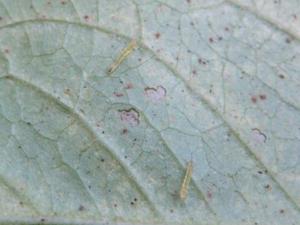

written by Andrea Locke, WNY PRISM Coordinator
The Western New York Partnership for Regional Invasive Species Management (WNY PRISM) provides the WNY region with best management practices for addressing invasive species management priorities. Most often this involves information regarding tools, methods, and strategies for the removal of individual species, but also includes assistance through education and outreach, management planning, spread prevention, and habitat restoration. We are fortunate in that for most invasive species we have effective means of management, however there are several species for which existing management options are not effective. This may be due to unique characteristics of the species or the habitat it is most often found, or it could simply be due to how widespread the species is. It is at this point when invasive species managers and researchers turn to the development of biological controls, or biocontrols, as a potential management tool.
Pale and black swallow-wort (Cynanchum rossicum, C. louiseae) are herbaceous, perennial, twining vines that outcompete native species and natural communities, decreasing biodiversity and structural diversity, inhibiting forest regeneration, and impeding recreation. Swallow-wort provides poor habitat and forage for native wildlife, including monarch butterflies. It’s unknown how often monarchs lay their eggs on swallow-wort, where they can’t survive, but it is expected to be higher in areas lacking the native common milkweed. Swallow-wort has also been shown to be allelopathic, inhibiting root growth in native species, including a 40% reduction in root development of butterfly weed.
Traditional management methods have shown to be ineffective against all but the earliest infestations of swallow-wort. Swallow-wort is able to self-pollinate (sexual reproduction is more common), high-density stands can produce 32,000 seeds per square meter and some seeds are polyembryonic. Plants can regenerate from root fragments and vegetative growth has both a waxy cuticle and contains a white-milky sap, similar to milkweeds. These characteristics hinder the effectiveness of mechanical, manual, and chemical treatments. When combined using an integrated pest management strategy, these methods can be successful, but there is a significant investment of time and money that most are unable to sustain.
Biocontrols are a component of an integrated pest management strategy that is defined as the reduction of pest populations by natural enemies and typically involves an active human role. When used in combination with other methods, it can lead to far greater sustained success with controlling certain invasive species. While biocontrols offer a powerful tool in the management of invasive species, we do remain cautious. The modern biocontrol approval process involves multiple rounds of testing and regulation to ensure the highest level of safety and target specificity.
Researchers have identified the moth Hypena opulenta as a biocontrol agent for pale and black swallow-wort. H. opulenta originates in Ukraine, from the same area as pale swallow-wort. Its larvae feed exclusively on the leaves of pale and black swallow-wort, defoliating the plants. H. opulenta produces more than two generations per year, with adults emerging in June and females laying eggs on the underside of swallow-wort leaves 2–5 days after emergence. The larvae create distinctive leaf “windows” as they begin feeding on the underside of the leaf, before eating the rest. The multiple, overlapping generations continue to stress and defoliate swallow-wort. H. opulenta was approved for release in the United States in August 2017 (previously approved for release in Canada) and efforts to establish and monitor test plots have been underway since.
The New York State Swallow-wort Research and Outreach Group was created to advance a two-tiered program related to the release of H. opulenta. The research objectives include development of mass rearing techniques, the study of H. opulenta establishment in the field, and to understand the impact of biocontrol on swallow-wort and native plant populations. The outreach objectives include informing land managers about swallow-wort and swallow-wort biocontrol, development of standardized monitoring protocol, and the establishment of demonstration sites across NYS.
WNY PRISM assisted with identifying release sites for H. opulenta and connecting researchers with appropriate land managers and organizations to gain permission and assistance with the demonstration projects. Two sites were selected in western New York: Clarence Oak Openings and Holley Falls Canal Park. WNY PRISM also assisted outreach efforts with the development of materials and installation of a boot brush station at Holley Falls Canal Park.
Results have been favorable with near 100% defoliation occurring in several demonstration sites over the 2020 and 2021 seasons. However, we have yet to see populations successfully overwinter in NYS, although this has occurred in Canada. Establishing self-sustaining populations will be essential to ensuring the success of this biocontrol. Continued site monitoring will take place at established demonstration sites in 2022 with additional releases planned at several of these sites.
If you would like to learn more about Hypena opulenta research in New York State, come to the WNY PRISM Spring Partner Meeting on April 21st at the Buffalo State Alumni Center, where Dr. Dylan Parry, Principal Investigator, will discuss the state of the science.
Image caption: H. opulenta larvae on a swallow-wort leaf at Clarence Oak Openings, NY.
Some content on this page is saved in PDF format. To view these files, download Adobe Acrobat Reader free. If you are having trouble reading a document, request an accessible copy of the PDF or Word Document.
